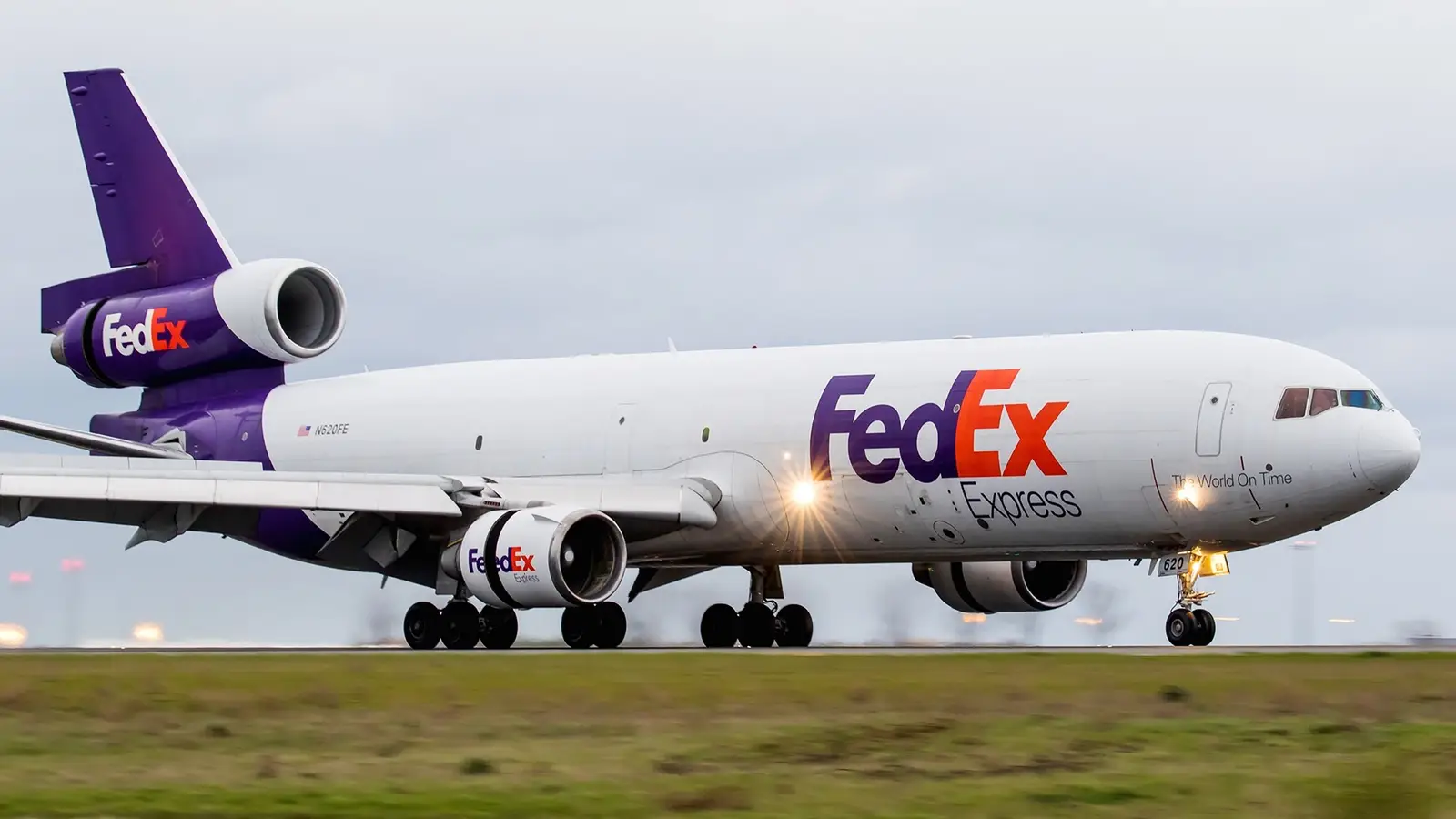
A Tri-jet design from the 1980s, iconic in its looks, the aircraft first took to the skies in 1990 and entered commercial service within the year of the type’s maiden flight. Various factors constrained the production of the type, which also failed to meet certain targets, leading to orders being downsized or canceled, with the production ultimately ending in early 2001.
Despite this, the MD-11s are still flying today, and data indicates they will be seen across the skies for quite a bit longer.
Firstly, Who Still Operates The MD-11?
Three operators hold a combined fleet of 56 MD-11s around the world
With the manufacturer, McDonnell Douglas, ending production of the type on February 22, 2001, Airways Magazine reports that the passenger version of the McDonnell Douglas MD-11 remained in commercial service until KLM retired the last of the type from its fleet on October 26, 2014.
However, it is worth noting that McDonnell Douglas built four different variants of the MD-11, which include: passenger, freighter, combi (accommodates both passengers and cargo), and convertible freighter
As is the case in the Aviation Industry, the freighter version of an aircraft tends to remain in commercial operation much longer than the passenger version. Thus, it is not surprising that, according to ch-aviation, a total of 56 freighter MD-11s (MD-11F) still remain across the fleet of 3 operators:
*The aircraft operated by Western Global Airlines is on behalf of the US Air Force
Furthermore, it is worth noting that all three of the above operators have a total of 42 MD-11s currently marked as “Stored”; however, it is highly unlikely these aircraft will return to active service.
The Future Of These Freighters
These MD-11s are planned to remain in service past 2030
Reports from Airways Magazine, and Freight Waves (1) and (2) all indicate that the two largest operators of the type, FedEx and UPS, have already planned to phase out the aircraft type from their respective fleets, with both carriers having their own plans.
In March this year, FedEx decided to use its option and purchase eight additional Boeing 777F and acquire 10 additional ATR-72-600 freighter aircraft for its regional operations.
With these new aircraft due to be delivered between 2027 and 2029, the MD-11s will be exiting the FedEx fleet between 2028 and 2032.
UPS, on the other hand, aims to replace its aging fleet of MD-11s with the Boeing 767Fs, and earlier this year, ch-aviation reported that UPS was behind the order placed last year by an undisclosed customer, with the operator upping its existing backlog of 767s on order by an additional eight Boeing 767-300Fs. The last of these new aircraft are due to be delivered around 2027, which indicates that UPS will also see the MD-11s exit its fleet by around 2030.
History Of The MD-11
The MD-11s were essentially designed as a replacement for the DC-10s
The idea for the MD-11 was spawned during the era when its predecessor, the DC-10 (also a tri-jet by McDonnell Douglas) needed a replacement. Reports suggest that the type faced considerable delays during the assembly phase of its prototype, resulting in subsequent delays in its entry into commercial service. However, by December 1990, the first of the type was delivered to MD-11’s global launch customer – Finnair, followed by the type’s US launch customer – Delta Air Lines.
With a new and digitized flight deck, the MD-11 allowed for double-crew operations compared to the DC-10s, which still required a flight engineer apart from the two pilots, thereby making operations for airlines more efficient and economical. Additionally, introducing winglets on the MD-11 ensured better operational efficiency, making the type desirable for the DC-10 operators during that time period.
While the MD-11 was marketed with these two key features, along with several other improvements in terms of passenger capacity, Maximum Take-Off Weight (MTOW), and better flight range. However, the aircraft failed to meet some of these metrics, such as payload and fuel efficiency, which subsequently reduced its operational range and interest from both existing and potential customers.
Changes To The Order Book
While some customers downsized the order for the jet, some customers outright canceled them
With customers being unhappy with the fact that the MD-11 was not meeting the operational targets the aircraft was marketed with, various operators began downsizing existing orders and some even canceling the entire order. A key example of this was Singapore Airlines, who proceeded to place an order with Airbus for the Airbus A340-300 aircraft.
Ultimately, only 200 airframes were built, which, when compared to the predecessor, the DC-10 sold *386 examples of the type.
*if the modified KC-10 tanker version is considered, it would equate to over 400 examples of DC-10 being sold.
Additionally, the introduction of the Boeing 777s and Airbus’ A330s and A340s into the market during this period made it difficult for the Tri-jet to compete effectively among the fierce competition offered by other widebody jets, ultimately resulting in the program being discontinued in the early 2000s.
However, it is worth noting that a smaller variant of the MD-11, introduced as MD-95 proceeded to become the Boeing 717 when McDonnell Douglas merged with Boeing.
New Jets And New Technology
Twin-jets are more efficient than tri-jets. Possible thanks to ETOPS
Considering that IATA reports, around 30% of an airline’s cost is attributed to fuel costs, and decades ago, the aircraft were not as efficient as the jets flying today, it can be assumed that even back then, airlines were keen on flying as efficiently as possible. Thus, it is easy to understand why airlines naturally preferred to invest in twin-jets such as the Airbus A330s and the Boeing 777s, instead of the three-engined MD-11.
This is also the primary reason why carriers preferred the A330s and Boeing 777s to quadjets such as the A340s and eventually the A380s and the Boeing 747s.
Apart from having fewer engines burning fuel, these twin-jets became practical due to the advent of ETOPS (Extended-range Twin-engine Operational Performance Standards). This allowed the A330s and the 777s to fly on more efficient flight paths, which they previously could not.
The UK CAA defines the function of ETOPS as the following:
“(ETOPS) permits twin-engined aeroplanes to operate over a route that contains a point further than one hour flying time at the approved one-engine inoperative cruise speed.”
In order to receive ETOPS approval for an aircraft, the operator has to meet the following two conditions:
An AOC (Air Operator Certificate)
Demonstrate that the necessary airworthiness, maintenance, and operational requirements are in place
Freighter Jets Of The Future
There are new freighter jets in the pipeline.
While there are still numerous operators flying freighter jets that are decades old, based on previous-generation aircraft designs, it is worth noting that some of the new freighter types currently in development have also gained traction in recent years. These are, namely, the freighter version of Boeing’s 777-X, which will be based on the Boeing 777-8, and Airbus’ A350F, which is based on Airbus’ hugely successful next-generation passenger jet, the A350.
While both aircraft types are yet to be built and certified, both manufacturers have received orders for the type, as operators with dedicated freighter aircraft are already planning to replace their existing fleets of Boeing and Airbus freighter jets.
Additionally, in the case of Airbus, the upcoming A350F will be well-suited for the manufacturer to effectively compete with Boeing within the cargo market. While Airbus has its A330Fs and A300Fs available for operators to use along with other converted aircraft, thus far, the cargo market has been dominated by Boeing with its extremely successful line-up of freight aircraft, which consists of the 777Fs, 767Fs, and the 747Fs.
Another important entry among next-generation freight jets, as reported by FlightGlobal, is Embraer’s E-Freighter. The first aircraft of the program, an E-190F, has just been delivered to the launch customer for the type, Malta-based Bridges Air. A key aspect of the E-Freighter program is that Embraer will not manufacture new freighter aircraft, but rather convert existing passenger E-190s (and eventually E-195) aircraft to freight aircraft.
Embraer markets the E-Freighter program as a way to bridge the gap in the market between smaller turboprop freight aircraft and larger jet-powered freight aircraft, making the regional aircraft suitable for offering efficient operational economics, and having a steady supply of aging passenger E-190s and E195s in the coming years, which can be converted and provided with a new lease of life as a cargo aircraft.
A key advantage of this aircraft conversion strategy is that Embraer will be shielded from most supply-chain issues that larger manufacturers, such as Airbus and Boeing, are currently facing in production, which subsequently result in delivery delays. Since the aircraft is already available, Embraer should be able to deliver its converted aircraft to its customers on time.



